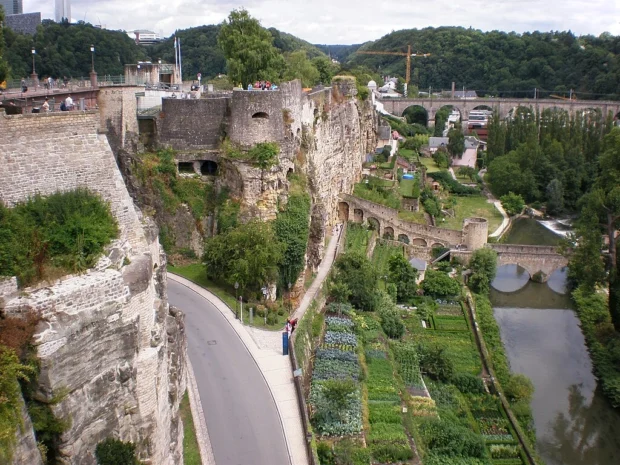Nestled in the heart of Luxembourg City, the Casemates du Bock unveils a labyrinth of history and architectural prowess that beckons travelers seeking a rich cultural experience. These underground fortifications, carved deep into the sandstone cliffs, narrate centuries of military strategy and survival. If you are passionate about medieval towns, heritage architecture, or simply walking through the quiet whisper of history, this site offers a stunning journey beneath one of Europe’s oldest fortified cities. Visitors often combine this excursion with tasting Luxembourg’s culinary heritage nearby, making it a sensory pleasure for both the mind and palate.
Table of Contents
You might also appreciate the grandeur of the Brandenburg Gate in Berlin, where history and architecture tell another powerful city story.
Unraveling Casemates du Bock: Fortress Beneath the City
The Casemates du Bock are not merely tunnels; they are a testament to Luxembourg’s strategic significance throughout history. Originally built in the 17th century by the Spanish, these fortress tunnels extended and fortified by successive rulers including the Austrians and the French. Within these subterranean passages, soldiers found shelter and launched defense operations during sieges. Today, walking through the cool, dimly lit corridors transports you back to a time of quiet vigilance and tense anticipation. The blend of rock and stone masonry, alongside narrow lookout points, offers a vivid experience of the past’s weight beneath the city streets.
The Symbol of Luxembourg’s Endurance
The Bock promontory itself is steeped in myth and history; it is said that this rocky outcrop was the birthplace of the city. The Casemates represent not only architectural innovation but also the resilience of Luxembourg. For centuries, despite being a small nation surrounded by larger powers, Luxembourg maintained its identity and independence, in part thanks to these formidable defenses. Exploring the tunnels, one feels the pulse of a city that has guarded its treasures and traditions through the shifting tides of European history.
Getting to Casemates du Bock: Simple Directions and Tips
Located in the Old Town of Luxembourg City, the Casemates du Bock are easily accessible from several key points. If you arrive by train, Luxembourg Gare Centrale is about a 15-minute walk uphill to the site, passing charming streets filled with local shops and cafes. From Luxembourg Airport, take a direct shuttle or public buses to the city center, then head towards Place Guillaume II, from where the Bock promontory is just a short stroll along the cobbled paths.
Public transport is frequent and efficient, while parking near the Old Town is limited. Walking or cycling is highly recommended for a fully immersive experience, allowing you to soak in the city’s atmosphere before descending into the tunnels.
Best Days and Hours to Visit
Visiting early in the morning or late afternoon on weekdays helps avoid crowds, allowing for a more reflective and personal tour of the Casemates. Weekends tend to draw larger groups, so if a quiet experience is your wish, midweek visits are ideal. Spring and autumn offer pleasant weather for wandering the surrounding Old Town streets and regional food markets afterwards.
Embracing the History: What You Should Know
The network of tunnels stretches about 17 kilometers, though only parts are open to the public. Initially created for military use, the Casemates were expanded through the centuries, making them a unique layer cake of European history. An intriguing detail is that during World War II, the Nazis used these tunnels as shelters, adding a darker chapter to their story. This multifaceted history enriches the visit with layers of narrative, each corner and archway whispering tales of conflict and community resilience.
What Visitors Often Miss
Many overlook the panoramic views the upper terraces provide after exploring the tunnels. The vantage point offers breathtaking sights over the Alzette River valley and the lush green landscapes that surround Luxembourg City. This contrast between the deep, dark tunnels and the bright, expansive cityscape outside encapsulates the dual nature of the place perfectly.
After exploring Luxembourg’s rich fortress history, consider diving into the vibrant coastal charm of Dubrovnik’s city and culture for a change of pace and seaside stories.
Planning Your Visit: Tours and Reservations
The Casemates du Bock can be visited independently with a ticket purchased on site, though guided tours offer a richer experience, full of stories and historical context. Booking a tour in advance is recommended during peak seasons to secure your spot. Many guides passionately detail the strategic importance of each tunnel and the architectural techniques used in their construction.
For multilingual visitors, some tours and audio guides are available in English, French, German, and Luxembourgish, making the visit accessible and engaging for international travelers. The official website provides up-to-date information on opening hours, ticket prices, and tour availability.
You can find more details by visiting the official Casemates du Bock website.
Where to Stay and Dine Near Casemates du Bock
After a profound journey underground, the nearby Old Town brims with accommodations that blend historic charm with modern comfort. Cozy guesthouses and inns are hidden in narrow streets, offering easy access back to the Casemates and other landmarks.
After exploring the underground fortress at Casemates du Bock, a stroll through the bustling streets and peaceful parks of Luxembourg City offers a perfect contrast to extend your visit. Check out Luxembourg City’s History, Flavors, and Hidden Corners for a glimpse of the city’s wider charm beyond the tunnels.
For dinner, indulge in Luxembourg’s regional cuisine just steps away. Traditional dishes such as Judd mat Gaardebounen (smoked pork with broad beans) or Gromperekichelcher (potato pancakes) capture hearty flavors reflecting the region’s agricultural heritage. Local bakeries and markets provide fresh seasonal produce perfect for a light snack. Sampling Moselle Valley wines in a quaint bistro nearby completes the culinary exploration beautifully.
Transport and Nearby Attractions
- From City Center: Walk uphill approximately 10-15 minutes from Place d’Armes through scenic alleys.
- From Luxembourg Airport: Take bus line 16 to Luxembourg Gare then walk or connect to line 10 towards the Old Town.
- Nearby Attractions: The Grand Ducal Palace, Notre-Dame Cathedral, and the charming pedestrian streets filled with craft shops and cafes.
- Cultural Stops: Don’t miss the National Museum of History and Art, providing context to the city’s rich past and artistic achievements.
A Final Reflection on the Casemates Experience
Walking through the Casemates du Bock is more than sightseeing; it is a dialogue with history itself. The cool stone corridors and the echo of footsteps remind us of those who shaped this small nation’s fate. Coupled with Luxembourg’s exquisite gastronomy and welcoming spirit, this experience offers more than a tour-it is an immersion into a living heritage. With every visit, the Casemates invite curiosity and respect, making it a deeply memorable chapter in any journey through Luxembourg.

Explorer of historic places and culinary traditions, combining landscape appreciation with food culture.
- Bockfelsen Luxemburg by Roland Struwe on Wikimedia Commons – cc by-sa 3.0
